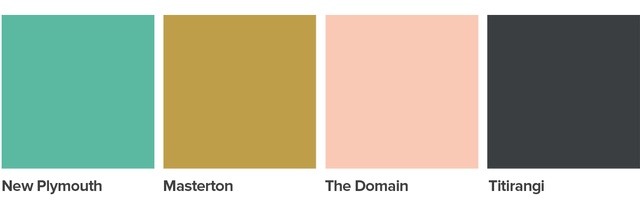Itinerary: Recent museums and galleries
In our Itinerary series, supported by Dulux, Andrew Barrie and Julia Gatley plan trips full of architectural discovery. This month: A nation-wide tour of architecture to house art.
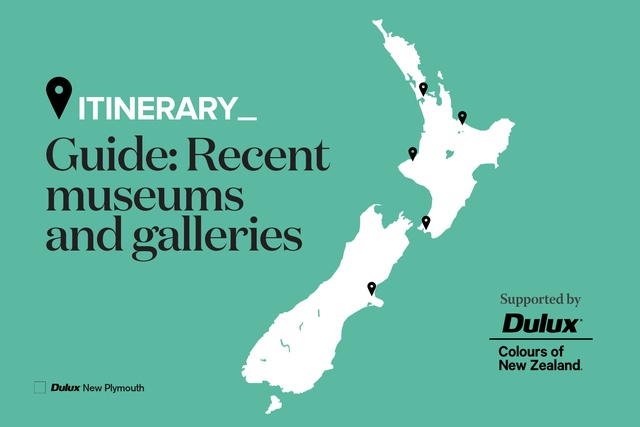
The ways in which museums and art galleries have evolved over the last generation can be seen from different perspectives. In one view, these institutions have sought to expand their offerings, bringing communities into lively engagement with their cultures, whether local or global, historical or contemporary.
A less sunny version of the drive to engage is that, like so much that was once assumed to be a ‘public good’, the proliferation of recreational options and a slow-grinding funding crunch have meant that our museums and galleries must continually justify their access to the public purse, usually by meticulously accounting for visitor numbers, followers and page views. Either way, these formerly high-minded institutions are increasingly opening up to their communities and localities. They seek to create facilities, exhibits and events that will draw people in and contribute to the richness of local life, particularly for those who, previously, might have felt museums and galleries were not places for them.
In rethinking these institutions, architects have looked in two, in many senses opposite, directions.
It is possible to see museums and galleries as places of education – extensions of the sequence of learning institutions that includes kindergartens, schools and university buildings. This museum-as-school conception, which seeks to grow understanding, indicates such moves as the inclusion of ‘education studios’, like those at the Len Lye Centre, or the large window in the foyer at the Auckland Museum that allows visitors to observe staff undertaking conservation work on objects.
Another model is the museum-as-living-room. If the school is the place of ongoing learning and self-improvement, the living room is the place of comfort and exchange. In addition to facilitating the usual interaction of people with artefacts, these buildings intentionally support exchange between people. These buildings have cafés in high-profile spots or set up circulation spaces – like those in Auckland Art Gallery – to be taken over by performance or presentation. It is perhaps optimistic but one can discern in the way these buildings seek to grow relationships, the rise of Māori values of manaakitanga (hospitality), whanaungatanga (belonging) and kotahitanga (togetherness).
A key notion in contemporary thinking about the places of community-building has been that of ‘third places’ – the social environments that are neither home on the one hand, nor work or school on the other. So, it is peculiar that it is generally easier to see, in these places, reflections of domesticity and education than to see typical third places, such as market places, clubs, churches or parks. One common inclusion, though, is an urban pathway, like Pātaka’s double-height ‘interior street’.
As is often the case with Kiwi architecture, a defining characteristic of these buildings is their modest means. The majority of them are adaptive reuse or renovation projects. Few exhibit the Instagram-ready flashiness that defines museum and gallery architecture internationally, and – Te Papa excepted – we see mercifully little emphasis on the blockbuster, exit-through-the-gift-shop version of cultural experience as entertainment.
There are many combined museum-galleries, perhaps reflecting the scales of the towns and cities in which they are built. We have one virtual museum – the New Zealand Fashion Museum – but there are conspicuous absences, such as the dedicated museums often seen abroad (agriculture? design?) and specialist Māori or Pacific museums.
Our museums and galleries reaching out and offering more can’t be a bad thing. But, we must ensure our civic institutions are properly funded – steadily rising expectations coupled with ongoing underfunding will eventually stretch their more-with-less ingenuity to the point of crisis. Further, it remains to be seen what damage the current pandemic will inflict on our civic life. We have to hope that the architectural and social structures these institutions have developed, and the highly tuned connections between them, don’t prove to be fragile.
THE ITINERARY
01. 1982 – Waikato Museum of Art and History
1 Grantham Street, Hamilton, by JASMaD
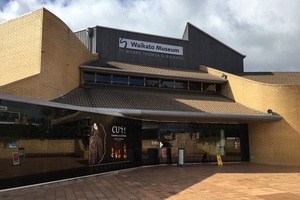
This is a relatively early Kiwi example of residential informality displacing civic decorum. Like so much of JASMaD’s work, the institutional building is reworked in the image of a house – this is a classic JASMaD amalgam of low-pitched roofs, strip windows and brick. It is regionalist or, in Jasmax’s own lexicon, “JASMaD vernacular”. An entry courtyard welcomes visitors, while the inclusion of gallery spaces with views out to the adjacent Waikato River is notable as, until recently, most of Hamilton’s CBD architecture turned its back on the river. The complex received an NZIA Local Award. See Architecture NZ May/June 1988.
02. 1993 – City Gallery Wellington
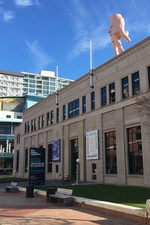
25 Harris Street / Civic Square, Wellington, by Architecture +
The City Gallery moved into Wellington’s old Public Library building in 1993, following the library’s move into its Athfield Architects-designed building next door. The old library building was designed by Gummer and Ford with Messenger, Taylor & Wolfe (1935–1940). Architecture + raised the ground level outside but retained the stripped classical façade along with the large former library spaces. Alterations in 2006–2009 included the addition of an auditorium in a spartan Corten box. The gallery earned NZIA National Awards in 1994 and 2011. See Architecture NZ Nov/Dec 1993.
03. 1995 – New Gallery, Auckland Art Gallery
Cnr Wellesley and Lorne Streets, Auckland, by Mitchell and Stout Architects
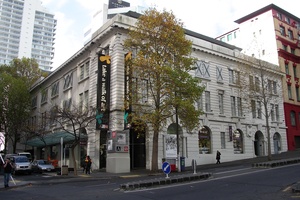
Another adaptive reuse project, this time of the former Auckland Post Office and Telephone Exchange. This was a four-storey building in which shops and a café at street level provided income to cover the gallery’s running costs. It was dedicated to the showing of contemporary art and had a dramatic light-well in the centre, illuminating a staircase that defined an urban path through the building. It closed in 2011 following extensions to Auckland Art Gallery’s main building across the road. The project earned an NZIA National Award in 2001. See Home & Building Oct/Nov 1995, Architecture NZ Jan/Feb 1995 and New Zealand Listener 4 Nov 1995.
04. 1989–1997 – Te Papa Tongarewa, Museum of New Zealand
55 Cable Street, Wellington, by Jasmax
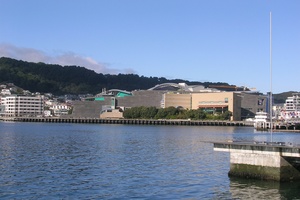
Te Papa must rank as New Zealand’s most high-profile museum building project of the last 40 years. The competition was controversial because it sought credentials rather than a design. The resulting building, with its Māori spaces to the north and non-Māori to the south, has been described as lumpy rather than iconic. But the facility nonetheless signals New Zealand’s embrace of the museum-as-entertainment and, right from its opening, it has been an unbridled success in attracting huge visitor numbers. See Architecture NZ Special Issue Feb 1998.
05. 1997–1998 – Pātaka Art + Museum
Cnr Parumoana and Norrie Streets, Porirua, by Architecture +
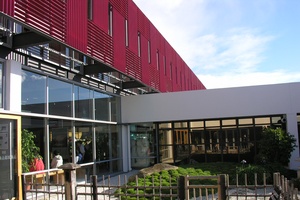
Pātaka, which translates as storehouse, opened in 1998, with the amalgamation of the Porirua City Library and Page 90 Art Gallery, and Porirua Museum. The building adapted and extended an existing office and warehouse facility. To connect and order the building’s various facilities (museum, gallery, library, courtyard, performance space and bookable meeting facilities), the architects inserted a spine that creates a double-height internal street – fire-engine-red paint and basket-weave louvres give the street an urban presence externally. The spine itself is also used for events. The project earned numerous awards, including an NZIA Resene Colour Award in 2000. See Monument 45 Dec 2001/Jan 2002.
06. 1996–1999 – Adam Art Gallery, Victoria University of Wellington
Kelburn Parade, Wellington, by Athfield Architects
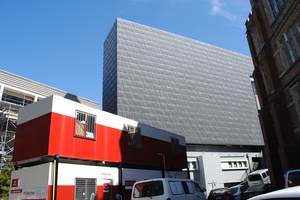
The Adam was New Zealand’s first university art gallery. The design was selected in a limited competition. It appears as a windowless shard, projecting out between two older buildings and clad in zinc. In fact, it links the older buildings, with a new foyer in the wedge-shaped space between them. Best use was made of an existing mid-20th-century staircase, which plunges downwards to provide access to the lower galleries. Double-height, long and narrow, the galleries in the zinc shard are the most distinctive. The building was the recipient of an NZIA Central Local Award in 2000. See Architecture NZ Nov 1999.
07. 2001–2002 Aratoi Wairarapa Museum of Art and History
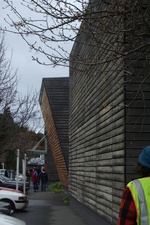
12 Bruce Street, Masterton, by Studio Pacific Architecture
Aratoi, which identifies as “the only public collection of artworks in Wairarapa”, started in 1969 as the Wairarapa Arts Trust and moved into its current facilities in 2002. The linear building runs almost the length of Bruce Street, dominated by three projecting wooden ‘vessels’, and incorporates an existing church as a gallery. There are white, flat-roofed links between the boxes and a courtyard space behind. Emphasising links to the community, the building features locally made materials. The project earned an NZIA National Award in 2002. See Architecture NZ May/Jun 2002.
08. 1997–2003 Puke Ariki
1 Ariki Street, New Plymouth, by Boon Goldsmith Bhaskar Brebner Team Architects
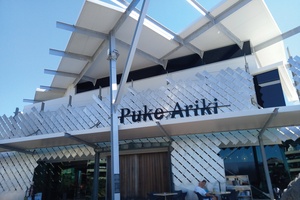
New Plymouth’s old museum and library formerly battled for space within the one building. A site for the new museum was decided in 1995, with the two facilities to be linked by a bridge across Ariki Street – hence the new building’s name. The new building echoes the hill of an old pā site. The marae atea sits above ground level, with the Māori Gallery at the highest point, under a whare-like roof. The varied material palette includes a woven façade and, internally, a four-storey void ensures clear circulation. The building was the winner of an NZIA Local Award in 2005. See Architecture NZ Sept/Oct 2003.
09. 1998–2003 Christchurch Art Gallery
Cnr Worcester Boulevard and Montreal Street, Christchurch, by Buchan Group
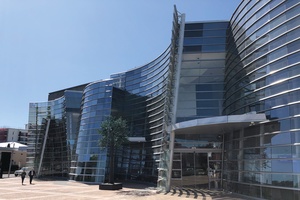
Christchurch’s art collection outgrew the old Robert McDougall Art Gallery building and a new site was purchased in 1996. A design competition in 1998 is thought to have been the first in 50 years for a dedicated art museum in New Zealand. Buchan Group’s design was demonstrably contemporary, with a front façade of curving glass and metal. Inside, a marble staircase provides a meeting point and access between the two floors of exhibition spaces. After the Canterbury earthquakes, the building was base isolated and repaired, reopening in 2015. See Liz Grant and Brendan Lee’s book, The Building (2003).
10. 1994–1999, 2003–2006 – Auckland War Memorial Museum Extension
Domain, Auckland, by Noel Lane Architects
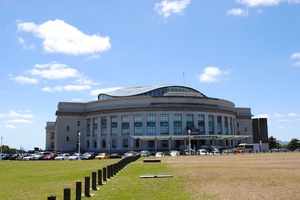
Grierson, Aimer and Draffin’s Auckland Museum building (1924–1929) is New Zealand’s finest expression of Greek Revival architecture. Noel Lane Architects transformed it for the 21st century from 1994 to 1999, with works including strengthening, repair and refurbishment, and earned an NZIA National Award in 2000. Stage II, from 2003 to 2006, extended the floor area by 60 per cent, across seven floors, including the landmark dome addition of copper and glass, above a suspended bowl clad in Fijian kauri. The building won an NZIA Local Award in 2009. See Architecture NZ Mar/Apr 2007 and Krzysztof Pfeiffer’s book, A Decade of Revival (2007).
11. 2001–2006 – New Dowse, The Dowse Art Museum
45 Laings Road, Lower Hutt, by Athfield Architects
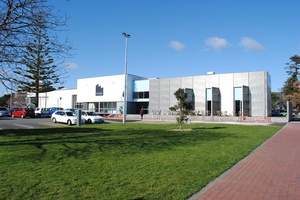
This limited competition-winning design included the refurbishment of the Dowse’s Structon-designed premises and a two-storey addition to provide multi-purpose space. The addition has perforated aluminium cladding, with perforations designed by Wellington artist Simon Morris, and three large doors to the café; slabs of colour mark the points of entry to the café. Inside, moveable walls ensure flexibility of use. They can be closed to create small spaces for performances or workshops, or opened to form one large space. The design was the winner of an NZIA Local Award in 2007. See Architecture NZ Mar/Apr 2007.
12. 2003–2007 – Tauranga Art Gallery
Cnr Willow and Wharf Streets, Tauranga, by Mitchell and Stout Architects
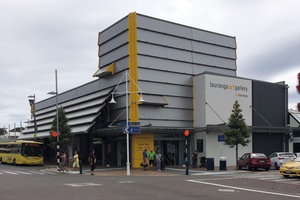
Hiding under the Tauranga Art Gallery is a 1960s-era BNZ building. The old columns, banking hall and vault remain extant, with the bank’s main spaces and its upper level lending themselves well to reuse as galleries. The exterior was re-clad with insulated panels, the walls were relined and new windows added. The interior is open and light, with a large double-height space, two new exhibition walls pinned to the mezzanine, and another double-height upstairs giving the appearance of a third floor. The gallery building won an NZIA National Award in 2009. See Architecture NZ Jan/Feb 2008.
13. 2009 – New Zealand Maritime Museum
Cnr Quay and Hobson Streets, Auckland, by Bossley Architects
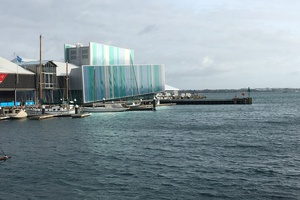
The Maritime Museum is a hub for exhibitions pertaining to people and the sea, as well as events and heritage sailings. It opened in 1993 in a Jasmax-designed shed at Hobson Wharf. KZ1, which competed in the 27th America’s Cup in 1988, was suspended outside the entrance in time for the opening. Pete Bossley’s extension followed in 2009, to showcase NZL32 – Black Magic – which won the 1995 America’s Cup. The building’s angled wall cladding, in rippling aqua-coloured polycarbonate, gives the impression of being out on a rolling ocean. The building won an NZIA National Award in 2010. See InDesign Dec 2010/Feb 2011 and Urbis 55 2010.
14. 2005–2011 – Auckland Art Gallery
Kitchener Street, Auckland, by FJMT + Archimedia in association
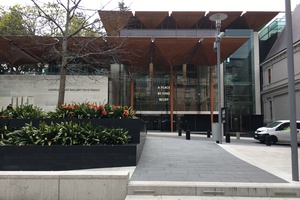
Built alongside Grainger and D’Ebro’s French Second Empire building (1884–1887), the Auckland Art Gallery extension replaced the 1970s-era Edmiston Wing. The new approach is defined by the tall columns and lofty roof, all wooden and smooth. Entry leads up to a key new double-height multifunctional space. The extension is open to the Grainger and D’Ebro building, and also to Albert Park, with a publicly accessible staircase to the street and direct entry to the second-floor café. This building has won awards galore, including two NZIA National Awards in 2012 and World Building of the Year at the World Architecture Festival, Singapore, 2013.
15. 2012–2014 – Te Uru Waitakere Contemporary Gallery
418 Titirangi Road, Auckland, by Mitchell and Stout Architects
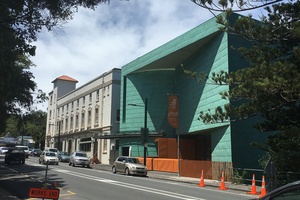
The Lopdell Precinct comprises Te Uru, Lopdell House and the Treasure House. Lopdell House became an art centre in the 1980s; Te Uru sits to its immediate west, connected by two glassy bridges. It has a sculptural street presence, with pre-patinated copper cladding and a recessed entry that leads to a curved staircase and a series of gallery spaces, enlivened by interpenetration across different floor levels, pop-out windows, top-lighting and, ultimately, a view to the Manukau Harbour. It was the winner of an NZIA National Award and short-listed for the World Architecture Festival, both in 2015. See Architecture NZ Nov/Dec 2015. The McCahon House is a short distance away.
16. 2009–2015 – Len Lye Centre
42 Queen Street, New Plymouth, by Patterson Associates Architects
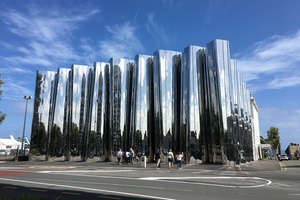
The Len Lye Centre, New Zealand’s only museum dedicated to a single artist, is an extension to the Govett-Brewster Art Gallery, and houses Lye’s collection and archive, including the permanent display of kinetic works. The building’s 14-metre-high, undulating and highly reflective steel façade is instantly recognisable and immensely entertaining, both as an object in its own right and as a backdrop for selfies. The curves are continued inside the street façades in concrete, giving way to the rectilinear elsewhere. See Home NZ Aug/Sep 2015 and Architecture NZ Sep/Oct 2015.
Other addresses
National Army Museum (1978) – State Highway 1, Waiouru, by Warren and Mahoney
Maritime Museum (1997–1999) – 2–3 Jervois Quay and Queens Wharf, Wellington, by Athfield Architects
Navy Museum (2010) – Torpedo Bay, Devonport, by Ken Davis, HMA and Opus in association
MOTAT Aviation Display Hall (2011) – 200–208 Meola Road, Auckland, by Studio Pacific Architecture
Museum Theatre Gallery (MTG) Hawke’s Bay (2010–2013) – 1 Tennyson Street, Napier, by Opus
The Suter Art Gallery Extension (2014–2016) – 208 Bridge Street, Nelson, by Jerram Tocker Barron and Warren and Mahoney in association
The itinerary series is supported by Dulux Colours of New Zealand. Dulux Colour Specialist Davina Harper has selected a Colours of New Zealand palette based on this itinerary. See the full range and order colour samples here.
